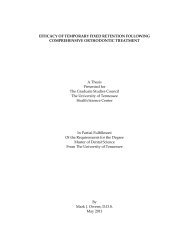BEVACIZUMAB EFFECT ON TOPOTECAN PHARMACOKINETICS ...
BEVACIZUMAB EFFECT ON TOPOTECAN PHARMACOKINETICS ...
BEVACIZUMAB EFFECT ON TOPOTECAN PHARMACOKINETICS ...
Create successful ePaper yourself
Turn your PDF publications into a flip-book with our unique Google optimized e-Paper software.
1.3 Rh30 Rhabdomyosarcoma as a Tumor Model<br />
1.3.1 Rhabdomyosarcoma<br />
Rhabdomyosarcoma (RMS) arises from immature cells that are developed to form<br />
striated skeletal muscle, but it can virtually arise at any site and in any tissue in the body<br />
except bone [102]. Head and neck are the most common regions where RMS occurs<br />
(approximately 40%); the genitourinary sites and the extremities are the next most<br />
frequent regions where RMS arises (approximately 20% each); and the remaining 20%<br />
RMS initiates from other sites, such as parameningeal sites and the retroperitoneum<br />
[103].<br />
The two most common pathologic types of RMS are embryonal and<br />
alveolar[102]. Embryonal rhabdomyosarcoma (ERMS) is the most common RMS seen in<br />
infants and young children, comprising of more than 60% of all RMS. The ERMS cells<br />
[104] exhibit the normal developing muscle cells, such as stellate undifferentiated<br />
mesenchymal cells, elongated myoblasts, multinucleated myotubes, and fully<br />
differentiated myofibers. ERMS has a better prognostic outcome [105-107] than other<br />
subtypes and tends to occur in the genitourinary tract, head and neck, and abdomen.<br />
About 20% of all rhabdomyosarcoma are of the alveolar histology (ARMS) [108], in<br />
which cells look like the mature muscle cells in a 10-week-old fetus. ARMS grows much<br />
faster than ERMS, needs more intensive treatment, has a higher relapse incidence and<br />
worse prognostic outcome[109].<br />
RMS occurs more frequently in children and adolescents (
















